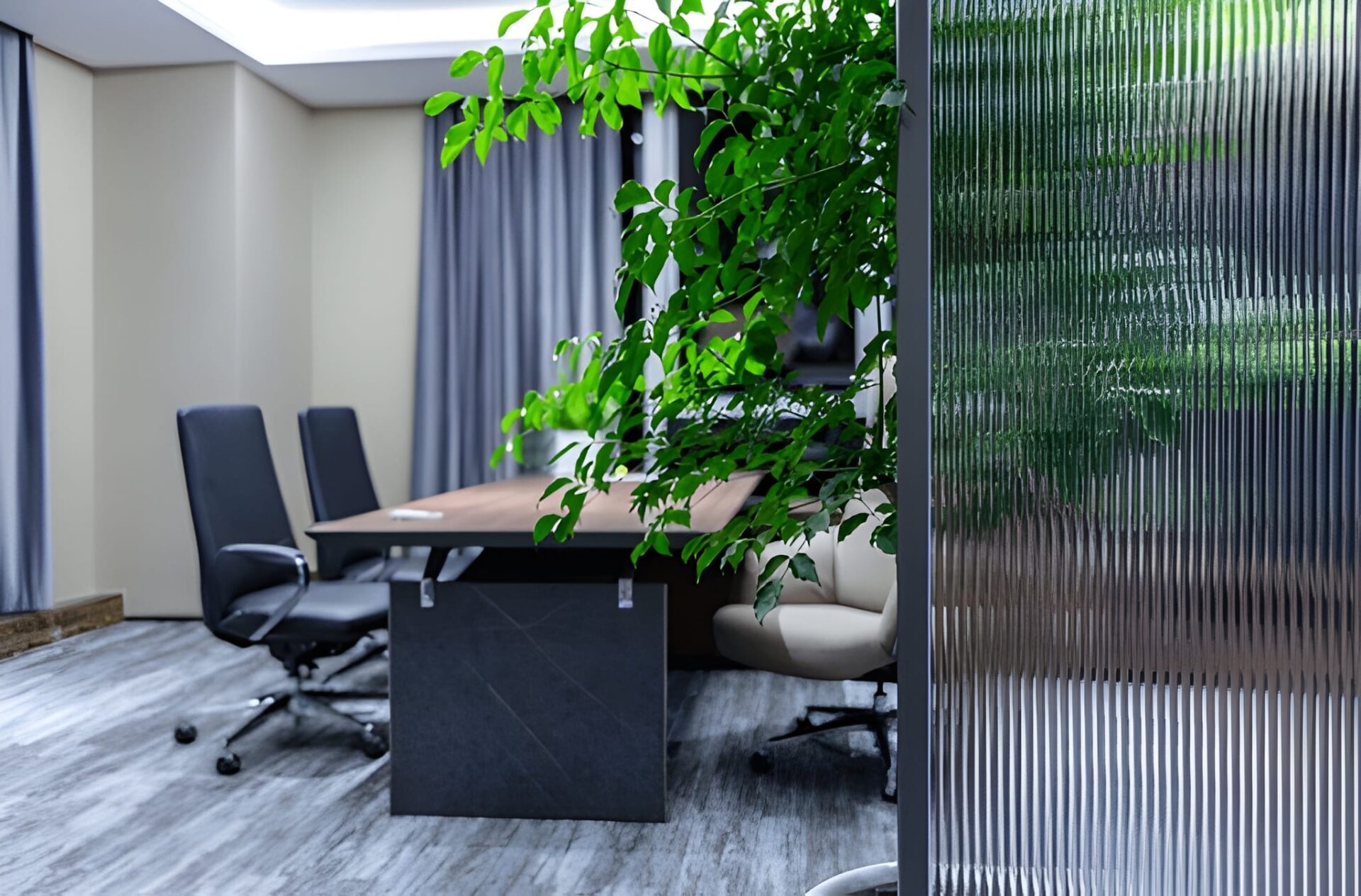
Textured glass has become a popular choice in both commercial and residential design, thanks to its ability to combine function with visual appeal. By introducing patterns, ridges, or motifs directly into the glass surface, it transforms a plain pane into a material that adds privacy, diffuses light, and elevates interiors with unique character.
In this article, you’ll discover what textured glass is, how it’s made, the different styles, its benefits, and the ways it can be used to transform spaces.
What Is Textured Glass?
Textured glass, also known as patterned glass, is standard glass that is shaped with patterns or designs on one or both surfaces during production. The texture ranges from subtle fluting or ripples to bold geometric, deep pebbles, waves, or vintage patterns, and partially obscures the view, so the glass lets daylight through while providing varying degrees of privacy and decorative interest. Because textures are formed into the glass itself and not a surface film, the effect is permanent and often used in indoor partitions, doors, windows, and decorations where appearance and performance matter.
How is Textured Glass Made?
There are two broad approaches, forming texture during manufacture and creating texture as a post-production surface treatment. Below are the common methods and what they deliver:
1. Formed During Manufacture: Here, texture is built directly into the glass surface while it’s still molten.
- Patterned or roller-pressed glass: Molten glass passes between patterned rollers, which imprint a continuous design such as flutes, ripples, or rain effects.
- Cast or moulded glass: Molten glass is pressed into moulds, creating deeper, three-dimensional or custom organic patterns.
2. Post-Production Surface Treatments: In this approach, texture is added after the glass is made, using mechanical or chemical processes.
- Acid etching: Chemicals dissolve a thin surface layer, leaving a smooth, satin-like finish that diffuses light.
- Sandblasting: High-pressure grit roughens the surface, producing frosted or patterned effects with varying opacity.
- Screen printing or ceramic frit: Durable enamel patterns are printed onto the glass and then fired, permanently fusing the design.
- Laminated textured glass: A patterned interlayer or two textured sheets are laminated together, enhancing strength and acoustic performance.
Key Features of Textured Glass
1. Light Diffusion: The textured surface scatters daylight, softening glare and keep interiors bright and welcoming.
2. Privacy Control: The patterns blur visibility, making textured glass ideal for meeting rooms, retail areas, and hospitality zones where discretion is important.
3. Design Versatility: It comes in a wide range of textures, finishes, and patterns, offering flexibility in design styles.
4. Durability & Safety Compliance: It is often toughened or laminated to meet safety standards in high-traffic commercial spaces.
5. Low Maintenance: The textured finish is resistant to fingerprints and smudges, reducing cleaning needs.
Common Types of Textured Glass for Partitions
1. Fluted or reeded: Features parallel linear ridges that can be vertical or horizontal. It creates an eye-catching visual effect and is popular for modern office and home partitions.
2. Frosted or Acid-etched: Created by sandblasting or acid-etching, this glass has a smooth, matte finish that offers a high level of privacy.
3. Patterned: Created by passing molten glass through embossed rollers, this technique imprints various designs, such as rain, wire, or other abstract motifs.
4. Seeded: Contains small air bubbles, or seeds, within the glass for a textured, organic, or rustic appearance.
5. Decorative or etched: Glass with intricate designs or patterns etched into the surface, which provides both artistic appeal and a degree of privacy.
6. Antique: Imitates the aged and textured appearance of vintage glass, adding a sense of history and charm.
Why Businesses Choose Textured Glass
1. Professional aesthetic and design flexibility.
2. Balance of style and functionality.
3. Boosts privacy without blocking light flow.
4. Supports brand image in commercial spaces.
Applications of Textured Glass Across Commercial Spaces
1. Offices: Textured glass softens visibility in partitions, meeting rooms, and reception areas while maintaining a bright, open environment.
2. Hospitality: Hotels, restaurants, and lounges use it for decorative walls, feature doors, and ambient lighting effects that set the mood.
3. Retail: Perfect for display backdrops, storefront accents, and fitting rooms where subtle privacy meets high visual appeal.
4. Healthcare & Leisure: Clinics, spas, gyms, and wellness centres integrate textured glass for hygienic surfaces that ensure discretion while keeping spaces inviting.
Textured Glass vs. Other Glass Options
| Comparison | Textured Glass | Other Glass Options |
| Textured vs. Frosted Glass | Offers patterns, tactile surfaces, and a range of designs | Frosted glass provides uniform opacity and soft, blurred visibility |
| Textured vs. Clear Glass Partitions | Blurs visibility, diffuses light, and adds design interest | Clear glass offers unobstructed views and maximum transparency |
| Textured vs. Decorative Patterned Glass | Patterns are often physical or raised; formed during manufacture or post-production | Decorative patterned glass can be printed or painted; smooth surface |
Things to Consider Before Installing Textured Glass
1. Choosing the Right Texture: Pick a pattern that controls visibility and light flow to suit the function of the space.
2. Safety & Compliance: Ensure glass is toughened, laminated, or meets relevant safety standards for commercial or residential use.
3. Cleaning and Maintenance: Textured surfaces resist fingerprints and smudges, but regular gentle cleaning keeps them looking fresh.
4. Budget and Cost: Consider the type of texture, production method, and installation requirements to align with your project budget.
Final Thoughts
Textured glass offers a versatile solution that combines style and functionality, making it ideal for commercial interiors. It enhances offices, retail spaces, hospitality areas, and healthcare facilities by controlling visibility, diffusing light, and adding visual interest. With options that meet safety standards and require minimal maintenance, textured glass delivers long-lasting performance.
FAQs
Yes, textured glass can be manufactured or laminated to meet specific fire-rating standards, making it suitable for commercial environments where safety is critical.
Textured glass can help reduce noise when laminated or combined with acoustic layers, making it ideal for offices, meeting rooms, and other busy commercial areas.
Absolutely. Laminating textured glass enhances its strength, prevents shattering, and ensures compliance with safety regulations in high-traffic spaces.
Yes, custom textures, patterns, or branded designs can be integrated during production or post-processing, allowing businesses to reflect their brand identity in interiors.
Yes, textured glass can be used in exterior façades, provided it is tempered or laminated to withstand weather conditions and comply with building codes.














